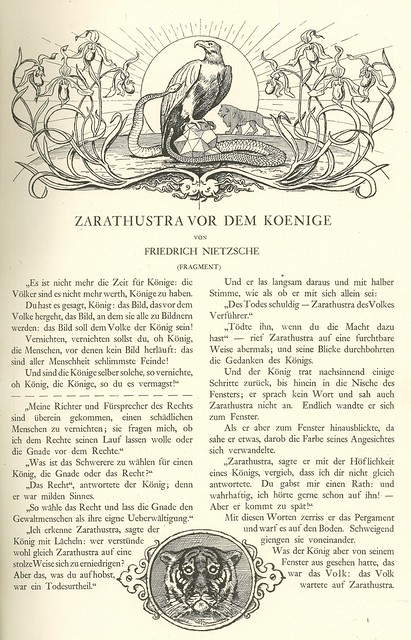Pan. Years I-V (all published). Edited by Julius Meier-Graefe and Otto Julius Bierbaum. A complete run of all five years, bound in 21 parts as issued (altogether 347, 351, 266, 267, 279 pp.) Sm. folio. Orig. wrpps., a few chips and tears at edges, some covers professionally repaired. Berlin (Genossenschaft Pan) 1895-1899. (45601)
In the late 19th Century, a new moon was rising over the old continent. Some caught sight of its glinting rays more quickly than others. In Berlin, the fiercely intellectual, young art critic Julius Meier-Graefe drew on his connections in Paris, Stockholm, Vienna and London to illuminate the pages of an ambitious new arts journal with works by the era’s brightest stars in painting and the graphic arts, among them Toulouse-Lautrec, Signac, Seurat, Vallotton and Zorn.


Artur Illies. Mondaufgang (Moonrise). Color etching with aquatint. Pan. Vol. II, no. 4. Berlin, 1896.
Named for the Greek god of pastoral reverie, Pan combined original prints in a variety of media with incendiary works of poetry, theater and philosophy. Together with Jugend and Simplicissimus, both of which emerged in Munich in 1896, the journal did much to define German Jugendstil sensibilities.

C. Grumbach. Kunstgewerbe. Ehrlich Waehrt am Laengsten (Honesty is the Best Policy). Original woodblock print on blue paper. Pan. Vol. I, no. 1. Berlin, 1895.

Hippolyte Petitjean. Dekorativer Entwurf (Decorative Sketch). Original five-color lithograph. Pan Vol. IV, no. 1. Berlin, 1899.

Ph. O. Runge. Pflanzenstudien mit Scheere und Papier (Plant Studies with Cuttings and Paper). Lithographic reproduction. Hamburger Liebhaber Bibliothek, ca. 1805. Pan. Vol. II, no. 4. Berlin, 1896.

Ludwig von Hofmann. Sonnige Tage (Sunny Days). Original lithograph. Pan. Vol. III, no. 4. Berlin, 1897.

Henri Héran. Spielendes Meerweib (Playful Mermaid). Original print combining lithography and woodcuts. Pan. Vol. III, No. 4. Berlin, 1897.
Meier-Graefe and co-editor Otto Julius Bierbaum found spiritual guidance in the writings of Friedrich Nietzsche. Instead of a manifesto of their own, Pan opens with a provocative excerpt from Also Sprach Zarathustra.

Portrait of Friedrich Nietzsche. Heliogravure after the painting by Curt Stoeving. Pan. Vol. I, no. 3. Berlin, 1895.
As Nietzsche wasted away from madness and disease over the five years of its existence, Pan helped to spread his cult among the German elite, with additional tributes, portraits and excerpts of his work appearing throughout its run.
But above all, it is the unyielding quality of Pan’s graphic work that continues to astound contemporary readers. Printed in runs of up to 1600 copies, each of the journal’s twenty one fascicles contains several prints, some of them subtly-tinted stone lithographs that must have required dozens of hours to execute and assemble for publication.
Though Meier-Graefe was forced out by his conservative German publishers after the first year of publication, the haunting tone he set for Pan remained in place throughout its lifespan. Diaphanous vistas and atmospheric city-scapes repeat throughout the run.

Ludwig von Hofman. Flötender Knabe (Boy playing Flute). Three-color collotype. Pan. Vol. V, no. 4. Berlin, 1899.

Franz Skarbina. Droschke im Regen (Carriage in the Rain). Original four-color lithograph. Pan. Vol. II, no. 1. Berlin, 1896.
True to its namesake, Pan pulses with erotic energy. Nymphs and satyrs dance across its pages. The entwined tendrils of Art Nouveau motifs drift from page to page, alongside candid evocations of sexual desire in word and image.

Wilhelm Volz. Aufzug und Tanz der Nymphen (Procession and Dance of the Nymphs). Original lithograph. Pan. Vol. IV, no. 2. Berlin, 1898.

Max Pletschmanm. Centaurenpaar (Pair of Centaurs). Original etching. Pan. Vol. II, no. 2. Berlin, 1896.

Albert Krüger. Venus Nach Sandro Botticelli (Venus after Sandro Botticelli). Original six-part woodcut. Pan. Vol. IV, no. 2. Berlin, 1898.
And authentic to its moment in history, the journal also reflects the anxiety and wildness of fin-de-siècle Europe.

Hans Unger. Wieblichen Studienkopf (Study of a Woman's Head). Original lithograph. Pan. Vol. II, no. 2. Berlin, 1986.

Albert Krüger. Böcklin’s Selbstbildnis mit Tod (Böcklin’s Self Portrait with Death). Woodcut in two colors. Pan. Vol. IV, no. 4. Berlin, 1898.
With a traveling exhibition currently making the rounds and a complete run of the journal scanned in digital form at the University of Heidelberg, there’s never been a better time for modern audiences to delve between its covers for unexpected treasures.
For those who care to take an even closer look, F.A. Bernett Books is pleased to offer an exceptionally rare complete set in original wrappers (minor repairs to some covers). For more information please contact us.
FAB Item I.D. # 45601














{ 2 trackbacks }
{ 1 comment… read it below or add one }
What a great survey of this fascinating periodical – I guess most people who hanker after owning a complete run of Pan will end up disappointed. But at least the whole thing has been digitised by the University of Heidelberg (http://www.ub.uni-heidelberg.de/Englisch/helios/fachinfo/www/kunst/digilit/artjournals/pan.html) – without the lovely photography in this post.